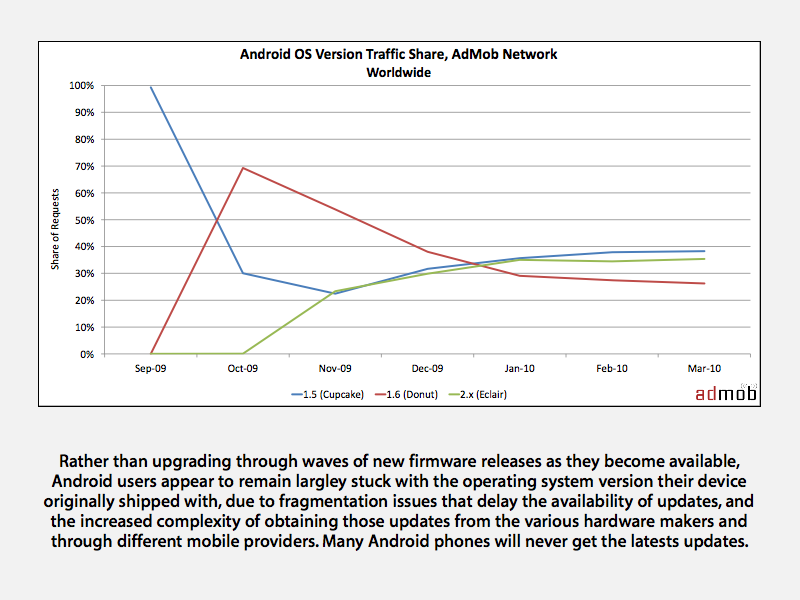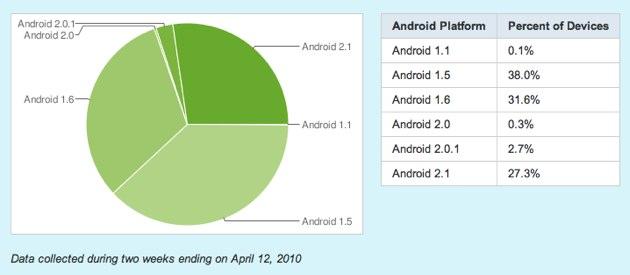As is the case with most other alternative smartphone platforms, Android users appear to often remain stuck with the firmware version their phone shipped with originally. This is primarily due to fragmentation problems that require the hardware maker, software platform vendor, and the mobile provider to work together to create and deliver custom updates for each model.
According to Android OS ad traffic figures published by AdMob, there was an initial migration from Android 1.5 "Cupcake" to 1.6 "Donut" last fall, followed by another shift to Android 2.x "Eclair" during the holiday season. But rather than being the result of user's software upgrade cycles, it appears that the shifts were largely the result of new hardware being sold with the new version already installed on it.
"In November 2009, Android 2.0 (Eclair) gained momentum with the launch of the Motorola Droid," AdMob reports, adding that "The Motorola Droid continues to generate the vast majority of requests of Android 2.0/2.1."
In March, AdMob pointed out that the ad traffic it was monitoring remained "divided relatively evenly between the three primary versions of the OS: Android 1.5 (38%), Android 2.0 / 2.1 (35%) and Android 1.6 (26%)."
The reason for that is that users of earlier models in many cases simply can't upgrade because there's no easy to install update for their phone. Many Android phone models do not get the latest operating system updates for months after the official update is completed, due to delays by the provider or hardware maker, either of which may want or need to address layers of customization they've made to the generic Android distribution.
Two weeks ago, Google published its own stats based on Android users visiting the Android Market software store, which reflected active users who download apps, and presumably would be more likely to be up to date.
Its figures indicate that only 27.3% of Android Market visitors are running the latest version of the Android OS, while nearly 70% are still using Android 1.1, 1.5 or 1.6. That prevents those users from being able to download the latest apps, including Twitter's new client for Android, which requires the 2.1 firmware version.
Apple manages OS updates and security patches for iPhone OS users as easy to install firmware updates that are available immediately through iTunes. The company has also historically alerted users of significant new updates via a text message. Apple has also pushed its third party developers to rapidly update their apps to ensure compatibility with major new releases, as it did last year with iPhone 3.0.
Apple's interest in broadly rolling out software updates to iPhone OS clients is largely to help developers target a single, unified installed base of users. This also encourages developers to make full use of the latest operating system features. The delivery of regular updates also head off issues related to bugs or security flaws.
 Prince McLean
Prince McLean








-m.jpg)






 Christine McKee
Christine McKee
 Marko Zivkovic
Marko Zivkovic
 Mike Wuerthele
Mike Wuerthele

 Amber Neely
Amber Neely
 Sponsored Content
Sponsored Content
 Wesley Hilliard
Wesley Hilliard










141 Comments
Wow. Huge difference from Apple. Must suck to have Android and be unable to upgrade to the latest OS when your phone may be brand new.
This is the down side of Android. Too many phone to support. Once again, the service providers have to do the legwork to provide an update. They don't want to. They only want to support new phones.
Apple has it right. Periodic, consistent updates, dropping support for models that haven't shipped in 2+ years (that way, few people are stuck in a contract with a phone they can't update).
Go Apple. Suck it, Android. You might do some things better, but on updates, you suck.
Is this not similar to what happens with the multitude of hardware driver fixes required so Windows can run on the PCs?
iDroid Dont update
This is going to hurt in the long and short run and does not bode well for the platform. Plus, Google failed to get a new phone to market a week or so ago, right?